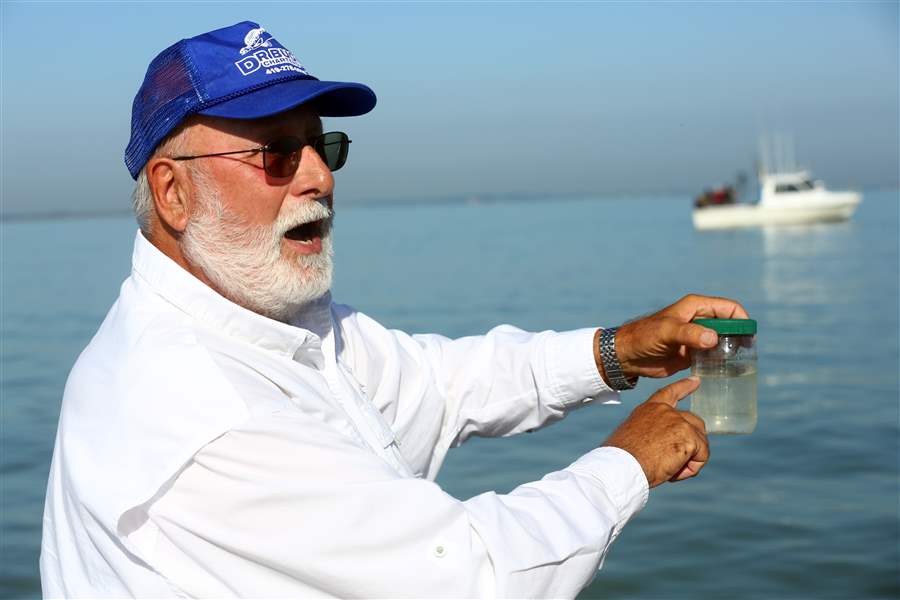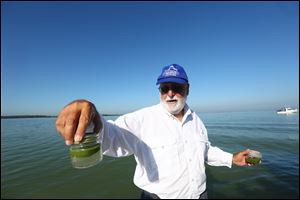
What happened to the Ohio Department of Agriculture?
6/2/2018
Captain Dave Spangler holds a sample of water from Maumee Bay in September, 2017.
The Blade
Buy This Image

Dave Spangler is the vice president of the Lake Erie Charter Boat Association.
Multiple heavy rain falls in early May sent too many nutrients out into Lake Erie. Yes, there will be another severe Harmful Algal Bloom (HAB) this year.
The silence coming from the Ohio Department of Agriculture has been deafening. Ohio EPA has just issued the second mass balance report verifying the initial report issued in December, 2016, that the Maumee River is the largest contributor of the nutrient-loading to Lake Erie with the Sandusky River being equally as bad. Phosphorus and nitrogen are the issue with 87 percent of those nutrients coming from the land.
There has been no movement to implement any policies or procedures that will effect any meaningful improvements to the loading issues. What is the department waiting for? Lake Erie has experienced heavy HABs for eight of the last 10 years. The two good years — 2012 and 2016 — experienced no heavy rain events. Nature has shown us twice that the problem comes from the land and yet we blindly march on. Where is the urgency?
In 2017, National Resources Conservation Services issued statements referring to 2016 data that 58 percent of the land in the Western Basin is at or below agronomic rates for phosphorus. We absolutely applaud those farmers and thank them very much. Unfortunately, that leaves 42 percent that need to get their act together, and now. The phosphorus goal is 40 parts per million (ppm), yet we have seen test results well over 100 ppm and some that are over 1,000 ppm. Certainly someone with results over 1,000 ppm cannot be called a steward of the land.
Everyone who works or lives along Lake Erie has been thrown under the bus for way too long. Do Not Drink warnings (Carroll Township, Toledo, Put-in-Bay, Pelee Island) and the annual water rate increases to combat the toxin, flat or lower property values, lower business income, fewer water recreation potentials, and the possibility of health issues have affected millions of people. The real rub is that none of these people had anything to do with creating the problem. Again we ask, when is there anything meaningful forthcoming from the Ohio Department of Agriculture?
A white paper that presented a summary of findings and strategies to move toward a 40 percent phosphorus reduction was issued Sept. 25, 2017. The writers have vast knowledge of HAB issues. In October, the International Joint Commission endorsed the recommendations of this study. The white paper has been widely distributed, yet, the Ohio Department of Agriculture has not moved on the proposals. If soil testing and adherence to agronomic rates were universal and all nutrients were injected into the ground, Lake Erie would see a vast improvement.
There are many things that could be done by the Ohio Department of Agriculture through their own issuing of rules. Why not have all animal operations run by nutrient management plans and permits? Why not change the manure application rate to match that of commercial fertilizer? Why not make all broadcast applications also be injected rather than just throwing the phosphorus on the ground? There still is a practice of applying more than a single year’s nutrients. Why?
There is a very important chart put out by the EPA that lists the concentrations of dissolved reactive phosphorus (DRP) in streams in the Maumee River watershed. Some of these streams are very high in DRP. It is very obvious where the work should start.
There is a very serious case of kick the can down the road by the Ohio Department of Agriculture. Lake Erie has been kicked in the can long enough. Do something.
Dave Spangler is the vice president of the Lake Erie Charter Boat Association.